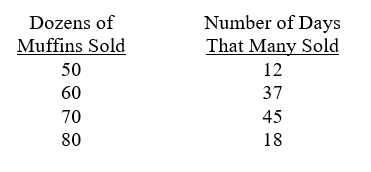Essay
A pastry store wants to know how many dozen muffins to bake each day.Every dozen they sell fresh in the shop returns a profit of $5.00.Every dozen they bake but do not sell on the day they are baked is given to a local charity at a loss of $3.00 a dozen.The business is fairly stable in that they never sell less than 50 dozen nor more than 80 dozen muffins.Their sales history, rounded to the nearest ten dozen muffins is as shown:
 They want to run a ten day simulation for production rates of 50, 60, 70, and 80 muffins to determine the profit (loss) for each.They generated the following random numbers for days 1-10 respectively: 63, 13, 67, 50, 71, 25, 44, 00, 56, and 68.
They want to run a ten day simulation for production rates of 50, 60, 70, and 80 muffins to determine the profit (loss) for each.They generated the following random numbers for days 1-10 respectively: 63, 13, 67, 50, 71, 25, 44, 00, 56, and 68.
a.What range of random numbers corresponds to 70 muffins sold?
b.What is the profit for day 3 if they make 70 dozen muffins?
c.What is the average daily profit (for all ten days) corresponding to 60 dozen muffins made?
Correct Answer:

Verified
a.Frequency = 45/(12 + 37 + 45 + 18) = ....View Answer
Unlock this answer now
Get Access to more Verified Answers free of charge
Correct Answer:
Verified
View Answer
Unlock this answer now
Get Access to more Verified Answers free of charge
Q4: A local legal aid office provides basic
Q15: The Excel function RAND( ) generates random
Q23: Which of the following is not an
Q24: Needing the actual time of arrival and
Q25: The table below shows the frequency of
Q27: A simulator is a general-purpose simulation model.
Q27: The queuing model operating characteristics formula only
Q28: Given the table below with information on
Q29: Differentiate and explain the importance of verification
Q30: A disadvantage of simulation models is that